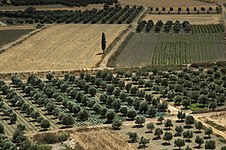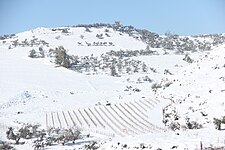Lehavim: Difference between revisions
| Line 175: | Line 175: | ||
===Foreign relations=== | ===Foreign relations=== | ||
[[File:Συνάντηση ΥΠΕΞ Ν. Κοτζιά με πρώην ΥΠΕΞ Ντόρα Μπακογιάννη (ΥΠΕΞ, 04.02.2015) (16258052117).jpg|230px|thumb|Leah Lebzelter, actual Minister of Foreign Affairs of Lehavim meeting foreign representatives. ]] | [[File:Συνάντηση ΥΠΕΞ Ν. Κοτζιά με πρώην ΥΠΕΞ Ντόρα Μπακογιάννη (ΥΠΕΞ, 04.02.2015) (16258052117).jpg|230px|thumb|Leah Lebzelter, actual Minister of Foreign Affairs of Lehavim meeting foreign representatives. ]] | ||
Lehavim is an active actor on the foreign relations scenery. The country maintains strong ties with most nations in the world and especially with those that have seen a great portion of the Lehavimi diaspora. The Lehavimi foreign relations are conducted from the Ministry of Foreign Relations and Cooperation, of which the Minister is the highest ranked person | Lehavim is an active actor on the foreign relations scenery. The country maintains strong ties with most nations in the world and especially with those that have seen a great portion of the Lehavimi diaspora. The Lehavimi foreign relations are conducted from the Ministry of Foreign Relations and Cooperation, of which the Minister is the highest ranked person; since the return of democracy, the country has boosted its international projection from a place of neutrality and seeking cooperation with other nations and although it has embassies and consulates in most regions of the world, Lehavim continues having territorial disputes with some of its neighbours and with the {{wp|Arab world}} regarding religious affairs. | ||
During the civic-military dictatorship and military junta, Lehavim experienced a strong alignment with other non-democratic regimes and with far-right or right governments, however, at the end of the period, Lehavim suffered a period of international isolation, which worked back then as preassure to the regime to impose several reforms and the transition towards a democratic state of right. Since then and following Progressive and People's administrations, the Ministry of Foreign Affairs have moved towards the depoliticization of its foreign agenda while recovering the prestige and international presence that held before the 60s and 70s, reenforced by the pursue of alliances and membership to several itnergubernamental organisations, such as _, _ and _. | |||
===Administrative divisions=== | ===Administrative divisions=== | ||
Revision as of 22:57, 2 March 2021
State of Lehavim לְהָבִים מְדִינַת (Lehavimi) Medinat Lehavim | |
|---|---|
| Capital and largest city | Habafar |
| Official languages | Lehavimi |
| Demonym(s) | Lehavimi |
| Government | Unitary parliamentary constitutional republic |
| Lavan Hefetz | |
• Premier | Irina Fleischer |
| Ahron Zahavy | |
| Legislature | Knesset |
| Area | |
• | 10,452 km2 (4,036 sq mi) |
| Population | |
• 2020 estimate | 6,859,408 |
• 2018 census | 5,122,641 |
• Density | 560/km2 (1,450.4/sq mi) |
| GDP (PPP) | 2020 estimate |
• Total | $310.743 billion |
• Per capita | $29,045 |
| GDP (nominal) | 2020 estimate |
• Total | $194.376 billion |
• Per capita | $18,168 |
| Gini (2020) | 31.0 medium |
| HDI | very high |
| Currency | Shekel |
Lehavim (Lehavimi: מְדִינַת), officially the State of Lehavim (Lehavimi: לְהָבִים מְדִינַת; Medinat Lehavim) is a sovereign state located in _. It is bordered by _ to the east, _ to the west, _ to the south and _ to the north. All of its coast is bathed by the _ Sea, which have historically provided the country with enormous connections across the region. The capital of Lehavim is Habafar, which concentrates most political and economical decisions.
The territory of Lehavim contains evidence of human transit and civilisations that date back to several thousands years ago. Its coastal towns have served throughout the history as important commercial ports in the _ Sea while the inland has been renowned for being rich in the production of olives, cheeses and vegetables. Archaeological sites from these periods have provided information about the importance given to farming, fishing and commerce by early maritime societies laced in the Lehavimi lands. Its strategic position made it heavily prone to suffer occupations from nearby powers that brought together with them, several cultural characteristics still visible in today's Lehavim. Although Jews have always formed the majority of the populaton and have been present for years in Lehavim, these periods of almost continuous occupations have left Christian and Muslim communities and cultural forms, which over the years, have created the Lehavimi national identity.
Lehavim was finally conquered by the _ Empire, an occupation under which it remained for over 500 years until the _ War. After the international conflict and the dismemberment of the _ Empire, the strategic position of Lehavim was positioned under _ influence and a mandate was created in order to assert !European political and economical interests in the region. The mandate lasted five years, in which _ was responsible for the defence and administration of the territory. The creation of the Lehavimi state was made possible, though, in 1954, when the first constitution was signed and independence granted. These first years of Lehavim were marked by relative stability and the first signs of economic prosperity, however, as the Jewish community started to take over most places in the high sphere of the government, problems arose with other minorities present in the territory; a coup d'état and subsequent instauration of a civic-military regime happened in 1961. Under the leadership of Abarron Hyamson and the armed forces, the de facto government created a confessional state with far-right characteristics, repressing political opponents and dissidents and using torture on a wide scale. In 1971, after Hyamson's death, the government was taken over by the military junta until the referendum of 1975, in which the military sought to renew its support but failed. A gradual democratisation was initiated with Josef Shmerkin, who inaugurated a new constitution and the Zeiman Pact between the largest political forces to consolidate the Lehavimi democracy. Since then, the country's political world has been dominated by the centre-left Progressives and the centre-right People's Party, which have alternated in power over the years.
Lehavim is today a unitary parliamentary constitutional republic, it counts with a unicameral legislature, the Knesset, and the country is led by the President and the Premier, who act as head of state and head of government respectively. It counts with a developed and advanced high-income economy, and a high quality of life; Lehavim ranks high in most educative, development and security indexes in the regional context.
History
Geography
Climate
Politics and government
Lehavim is a unitary parliamentary constitutional republic, its political system has been, since the return of democracy, well settled in a multi-party system that has granted a high level of political stability. The current Constitution of Lehavim was put into force after the fall of the military junta in 1975 and is the fourth that has been in use since the creation of the Lehavimi state. The constitution recognises the socially preponderant position of the Jewish religion although puts on a high level of importance religious freedom and the state defence of all religions, the constitution recognises also important civil rights and the adoption of a social state. The Head of State of the State of Lehavim is the President and the Head of Government is the Premier; although both are regarded as the highest levels in the political scene of the country, Presidents have been merely ceremonial figures.
The government is separated into three branches:
- Executive: is led by the President, who is also commander-in-chief; the person who is holding the office is responsible of forming cabinets by appointing ministers and the Premier and has the power to impose a veto on laws passed by the Knesset. Other figures of the executive are the ministers and the Premier.
- Legislative: consolidated in the Knesset, a unicameral legislature composed by 125 members who are responsible of enacting laws, approving budgets, providing confidence for the Premier and its cabinet and controlling the government.
- Judiciary: consisting of secular and religious courts and overseen by the Supreme Court of Lehavim, which is composed by 15 judges and presided by the President of the Supreme Court and the Minister of Justice.
While the President of Lehavim is elected every six years and has the option of one renew in power, Premiers are appointed by the Chief of the Executive after general elections and their terms have no length, although legislatures are usually fixed to five years. Premiers are appointed by the President on the behalf that they count with the needed confidence from the Knesset, this leads to winning political parties to form coalitions and alliances with other similar formations in order to form governments. Premiers can hold the office until the end of the legislature or advice the President to dissolve the Knesset and set a date for earlier elections. Since the return of democracy, only three political parties have hold the Premiership and in the last decades, two have dominated the political scenario, which are the Progressives (Lehavimi: מפלגה פרוגרסיבית) and the People's Party (Lehavimi: המפלגה העממית), representing the social democracy and the right-wing economic liberalism.
Foreign relations
Lehavim is an active actor on the foreign relations scenery. The country maintains strong ties with most nations in the world and especially with those that have seen a great portion of the Lehavimi diaspora. The Lehavimi foreign relations are conducted from the Ministry of Foreign Relations and Cooperation, of which the Minister is the highest ranked person; since the return of democracy, the country has boosted its international projection from a place of neutrality and seeking cooperation with other nations and although it has embassies and consulates in most regions of the world, Lehavim continues having territorial disputes with some of its neighbours and with the Arab world regarding religious affairs.
During the civic-military dictatorship and military junta, Lehavim experienced a strong alignment with other non-democratic regimes and with far-right or right governments, however, at the end of the period, Lehavim suffered a period of international isolation, which worked back then as preassure to the regime to impose several reforms and the transition towards a democratic state of right. Since then and following Progressive and People's administrations, the Ministry of Foreign Affairs have moved towards the depoliticization of its foreign agenda while recovering the prestige and international presence that held before the 60s and 70s, reenforced by the pursue of alliances and membership to several itnergubernamental organisations, such as _, _ and _.










